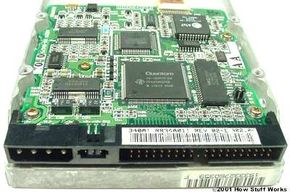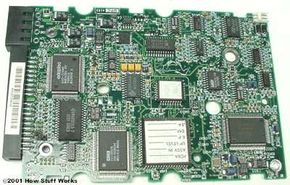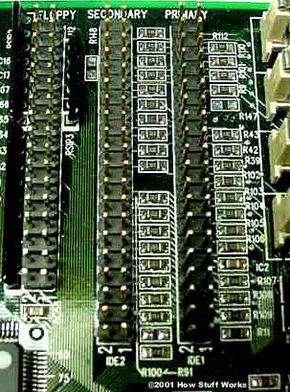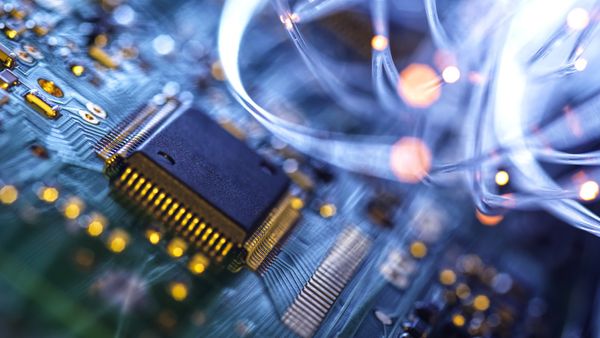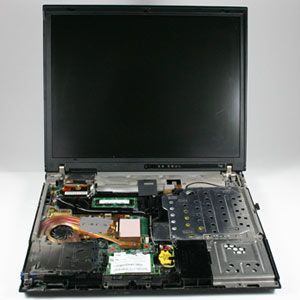Mostmotherboardscome with an IDE interface. This interface is often referred to as an IDE controller, which is incorrect. The interface is actually ahost adapter, meaning that it provides a way to connect a complete device to the computer (host). The actual controller is on a circuit board attached to the hard drive. That's the reason it's called Integrated Drive Electronics in the first place!
While the IDE interface was originally developed for connecting hard drives, it has evolved into the universal interface for connecting internal floppy drives, CD-ROM drives and even some tape backup drives. Although it is very popular for internal drives, IDE is rarely used for attaching an external device.
There are several variations of ATA, each one adding to the previous standard and maintaining backward compatibility.
The standards include:
ATA-1- The original specification that Compaq included in the Deskpro 386. It instituted the use of a master/slave configuration. ATA-1 was based on a subset of the standard ISA 96-pin connector that uses either 40 or 44 pin connectors and cables. In the 44-pin version, the extra four pins are used to supply power to a drive that doesn't have a separate power connector. Additionally, ATA-1 provides signal timing fordirect memory access(DMA) and programmed input/output (PIO) functions.DMAmeans that the drive sends information directly to memory, whilePIOmeans that the computer'scentral processing unit(CPU) manages the information transfer. ATA-1 is more commonly known as IDE.
ATA-2- DMA was fully implemented beginning with the ATA-2 version. Standard DMA transfer rates increased from 4.16 megabytes per second (MBps) in ATA-1 to as many as 16.67 MBps. ATA-2 provides power management,PCMCIA cardsupport and removable device support. ATA-2 is often called EIDE (Enhanced IDE), Fast ATA or Fast ATA-2. The total hard drive size supported increased to 137.4 gigabytes. ATA-2 provided standard translation methods forCylinder Head Sector(CHS) for hard drives up to 8.4 gigabytes in size. CHS is how the system determines where the data is located on a hard drive. The reason for the big discrepancy between total hard drive size and CHS hard drive support is because of the bit sizes used by the basic input/output system (BIOS) for CHS. CHS has a fixed length for each part of the address:
- Cylinder = 10-bit, 1024
- Head = 8-bit, 256
- Sector = 6-bit,63*
You will note that the number of sectors is 63 instead of 64. This is becausea sector cannot begin with zero。Each sector holds 512 bytes. If you multiply 1,024 x 256 x 63 x 512, you will get 8,455,716,864 bytes or approximately 8.4 gigabytes. Newer BIOS versions increased the bit size for CHS, providing support for the full 137.4 gigabytes.ATA-3- With the addition of Self-Monitoring Analysis and Reporting Technology (SMART), IDE drives were made more reliable. ATA-3 also adds password protection to access drives, providing a valuable security feature.
ATA-4- Probably the two biggest additions to the standard in this version are Ultra DMA support and the integration of theAT Attachment Program Interface(ATAPI) standard. ATAPI provides a common interface for CD-ROM drives, tape backup drives and otherremovable storagedevices. Before ATA-4, ATAPI was a completely separate standard. With the inclusion of ATAPI, ATA-4 immediately improved the removable media support of ATA. Ultra DMA increased the DMA transfer rate from ATA-2's 16.67 MBps to 33.33 MBps. In addition to the existing cable that uses 40 pins and 40 conductors (wires), this version introduces a cable that has 80 conductors. The other 40 conductors are ground wires interspersed between the standard 40 conductors to improve signal quality. ATA-4 is also known as Ultra DMA, Ultra ATA and Ultra ATA/33.
ATA-5- The major update in ATA-5 isauto detectionof which cable is used: the 40-conductor or 80-conductor version. Ultra DMA is increased to 66.67 MB/sec with the use of the 80-conductor cable. ATA-5 is also called Ultra ATA/66.

